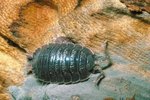
Whether diurnal or nocturnal, there are several squirrel-like scampering animals being sold as exotic pets. These are high energy creatures when they are awake, and they have long life spans in captivity. Think carefully before taking one home, though. Your pet's charm may wear off once the reality of caring for him sets in.
Sugar Gliders
Sugar gliders are native to Australia and Indonesia. They are also called sugar bears, honey gliders and sugar squirrels, although they are not squirrels at all. These small, omnivorous marsupials live in trees, and have skin flaps that allow them to glide effortlessly from tree to tree. Sugar gliders are generally grey or brown with a dark stripe down the middle of their back and along their limbs. Their underside is light-colored. They are furry creatures with a bushy tail that cannot be used to grasp limbs. They are often categorized as pocket pets by exotic breeders. These adorable creatures crave company. Though they sleep during the day, they enjoy being carried around in your pocket near to your heart as they sleep. In the evenings, they enjoy riding around on your shoulder, or running lose in a secure room. It is illegal to own sugar gliders in some places, so research your state and local laws before purchasing a sugar glider.
Chipmunks
Siberian chipmunks are native to Korea, and the only chipmunk species that is not found in North America. They are the most popular chipmunks kept as pets. Chipmunks are burrowing rodents who are active from dawn to dusk. These acrobatic creatures are lively and entertaining. They are not cuddly creatures; they prefer to ride around on your shoulder instead of being held. Chipmunks can live up to 12 years in captivity. They are smaller than most tree squirrels and are usually brown with dark stripes down their back. They have bushy tails that they sometimes flip over their back to cover their body and face during rainy weather. It is illegal to own chipmunks in many places, so you will need to research your state and local laws before purchasing a chipmunk.
Chinchillas
Native to the Andes mountains, chinchillas are furry rodents who are larger than guinea pigs. They have perky round ears and a bushy tail. They come in a variety of colors from white to black. Chinchillas can live to be as much as 20 years old. They are nocturnal animals, and they don’t tolerate heat and humidity well. Chinchillas are curious and energetic creatures. Because their teeth grow rapidly and continuously, they are constantly gnawing on things. Don't allow them to run loose because they can destroy your home’s furnishings, and may cause harm to themselves by chewing electrical cords or toxic items. Check your state and local laws before purchasing a chinchilla, and be sure that you see documentation that your chinchilla was bred in the United States. They are endangered in their native habitat, so it is illegal for them to be imported into the United States.
Dormice
African pygmy dormice, sometimes called micro-squirrels, were once very popular exotic pets in the U.S. In 2003 a monkey pox outbreak prompted the Centers for Disease Control and Prevention to ban the import, sale and transportation of several groups of exotic African pets, including African pygmy dormice. These rodents can be infected by monkey pox, and it is possible for the disease to be passed on to people. Though some of the restrictions have now been lifted, it is still extremely difficult to own these exotic pets in the U.S. These fascinating creatures are still available for sale in some other countries, along with other species of dormice that are native to Europe. The edible dormouse, also called a glis glis, is sometimes kept as a pet in European countries. Because many dormice species are endangered, there are some restrictions against capturing wild dormice or destroying their habitat. Dormice are small rodents who have long bushy tails, mouse-like ears and come in brown or gray colors. Though extremely dexterous and active during warm weather, dormice are famous for sleeping half their life away during winter hibernation.
References
- SmallAnimalChannel.com: Quick Sugar Glider Facts
- SmallAnimalChannel: Chinchilla Stats
- Millermeade Farms Critter Connection: Animal Library: Dormice
- Journal of the American Association for Laboratory Animal Science: Management and Care of African Dormice (Graphiurus kelleni)
- 2ndChance.info: Do Chinchillas Make Good Pets?
- Association of Sugar Glider Veterinarians: Sugar Glider Information
- Pet Care GT: Pet Chipmunk
Resources
Photo Credits
-
Jupiterimages/Photos.com/Getty Images
Writer Bio
Jenny Newberry, a former teacher with 25 years of experience, is a professional writer and photographer and holds a B.S. and a M.Ed. in elementary and special education from the University of South Alabama. She is also a history buff, praise and worship pianist, pet enthusiast, avid crafter and hobby gardener.




